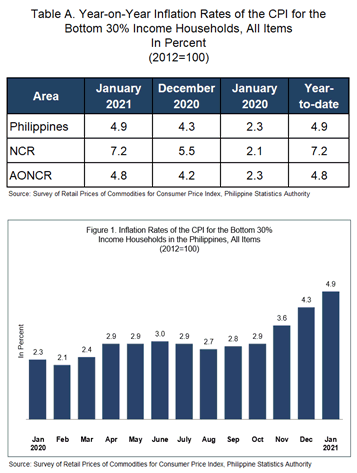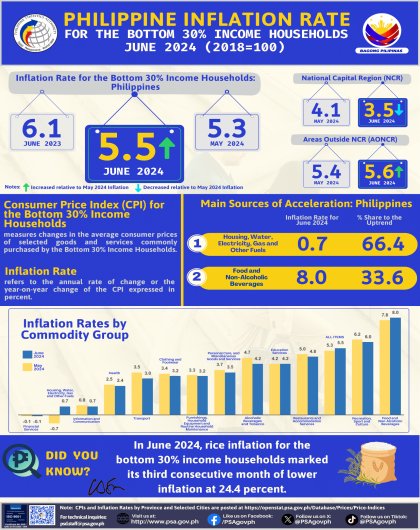1. Philippines

The country’s inflation for the bottom 30% income households accelerated further to 4.9 percent in January 2021. This was the highest inflation recorded since February 2019.
In December 2020, inflation for this income group of consumers was posted at 4.3 percent, and in January 2020, 2.3 percent. (Table A and Figure 1)
The uptrend in the inflation at the national level was mainly due to the higher annual increase in the index of the heavily-weighted food and non-alcoholic beverages at 4.6 percent during the month. Its annual rate in December 2020 was noted at 3.6 percent.
In addition, annual increments were faster in the indices of the following commodity groups in January 2021:
a. Housing, water, electricity, gas, and other fuels, 1.8 percent;
b. Furnishing, household equipment and routine maintenance of the house, 1.7 percent;
c. Health, 2.9 percent;
d. Transport, 18.3 percent; and
e. Restaurant and miscellaneous goods and services, 3.7 percent.
The indices of the rest of the commodity groups remained at their previous month’s annual growth rates. (Tables 3 and 4)
Food inflation at the national level went up further to 4.8 percent at the beginning of the year. In December 2020, its annual rate was observed at 3.7 percent and in January 2020, 0.6 percent. (Table 7)
The indices of the following food groups exhibited higher annual upticks during the period:
a. Meat, 12.6 percent;
b. Fish, 3.6 percent;
c. Oils and fats, 4.4 percent;
d. Fruits, 11.7 percent; and
e. Vegetables, 19.2 percent.
Moreover, the indices for rice; and sugar, jam, honey, chocolate and confectionery recorded annual hikes of 0.1 percent and 0.3 percent, respectively, from zero percent annual rate in December 2020.
Slower annual increments were, however, observed in the indices of other cereals, flour, cereal preparation, bread, pasta and other bakery products at 2.3 percent; milk, cheese and eggs, 3.2 percent; and food products, not elsewhere classified, 5.8 percent.
The index for corn continued to move downward as its annual rate dropped by -1.1 percent during the month. (Table 5)
| Table B. Year-on-Year Inflation Rates of the CPI for the Bottom 30% Income Households in the Philippines, All Items January 2017 – January 2021 (2012=100) | |||||
| Month | Year | ||||
| 2017 | 2018 | 2019 | 2020 | 2021 | |
| January | 2.0 | 3.6 | 5.2 | 2.3 | 4.9 |
| February | 2.2 | 4.4 | 4.3 | 2.1 | |
| March | 2.2 | 5.0 | 3.4 | 2.4 | |
| April | 2.4 | 5.2 | 3.1 | 2.9 | |
| May | 2.1 | 5.4 | 3.2 | 2.9 | |
| June | 2.1 | 5.4 | 3.1 | 3.0 | |
| July | 1.9 | 6.2 | 2.5 | 2.9 | |
| August | 2.3 | 6.9 | 1.7 | 2.7 | |
| September | 2.5 | 8.0 | 0.2 | 2.8 | |
| October | 2.7 | 8.1 | -0.1 | 2.9 | |
| November | 2.6 | 7.3 | 0.7 | 3.6 | |
| December | 2.7 | 6.3 | 1.9 | 4.3 | |
| Average | 2.3 | 6.0 | 2.4 | 2.9 | |
Source: Survey of Retail Prices of Commodities for Consumer Price Index, Philippine Statistics Authority
2. National Capital Region (NCR)
Inflation for the bottom 30% income households in NCR, likewise, jumped to 7.2 percent in January 2021. Inflation in the area in December 2020 was 5.5 percent and in the same month in 2019, 2.1 percent. (Tables A and 3)
The double-digit annual increase of 11.0 percent in food and non-alcoholic beverages index during the month primarily pushed up the inflation in the area. Moreover, annual increments were higher in the indices of alcoholic beverages and tobacco at 13.4 percent; health, 1.8 percent; and education, 0.8 percent.
Likewise, the annual rate of the index of housing, water, electricity, gas, and other fuels went up by 0.6 percent during the month, from an annual decline of -0.6 percent in December 2020.
On the contrary, slower annual growth rates were recorded in the indices of furnishing, household equipment and routine maintenance of the house at 1.1 percent; transport, 23.2 percent; and restaurant and miscellaneous goods and services, 1.5 percent. Meanwhile, the annual rate of the index of communication declined further by -0.4 percent during the period.
The indices of the rest of the commodity groups retained their previous month’s annual growth rates. (Tables 3 and 4)
3. Areas Outside NCR (AONCR)
Similar to the trend at the national level and in NCR, inflation for this particular income group of consumers in AONCR went up further to 4.8 percent in January 2021. In the previous month, inflation in the area was posted at 4.2 percent and in January 2020, 2.3 percent. (Tables A and 3)
Higher annual increases were noted in the indices of the following commodity groups during the month:
a. Food and non-alcoholic beverages, 4.4 percent;
b. Furnishing, household equipment and routine maintenance of the house, 1.8 percent;
c. Transport, 18.1 percent; and
d. Restaurant and miscellaneous goods and services, 3.9 percent.
Moreover, the index of recreation and culture registered a 0.1 percent annual rate during the month, from zero growth in the previous month.
The indices of the rest of the commodity groups retained their previous month’s annual growth rates. (Tables 3, and 4)
Thirteen (13) regions in AONCR had higher inflation for the bottom 30% income households in January 2021. The highest inflation among the regions outside NCR during the month remained in Region II (Cagayan Valley) at 8.6 percent, while the lowest inflation was still observed in Region IX (Zamboanga Peninsula) at -1.1 percent. (Table 4)
Note:
Consumer Price Indices (CPIs), and inflation rates for the bottom 30% income households by province and selected city are posted at the PSA website (http://openstat.psa.gov.ph/).
See more at the Consumer Price Index for Bottom 30% Income Households Main page.

